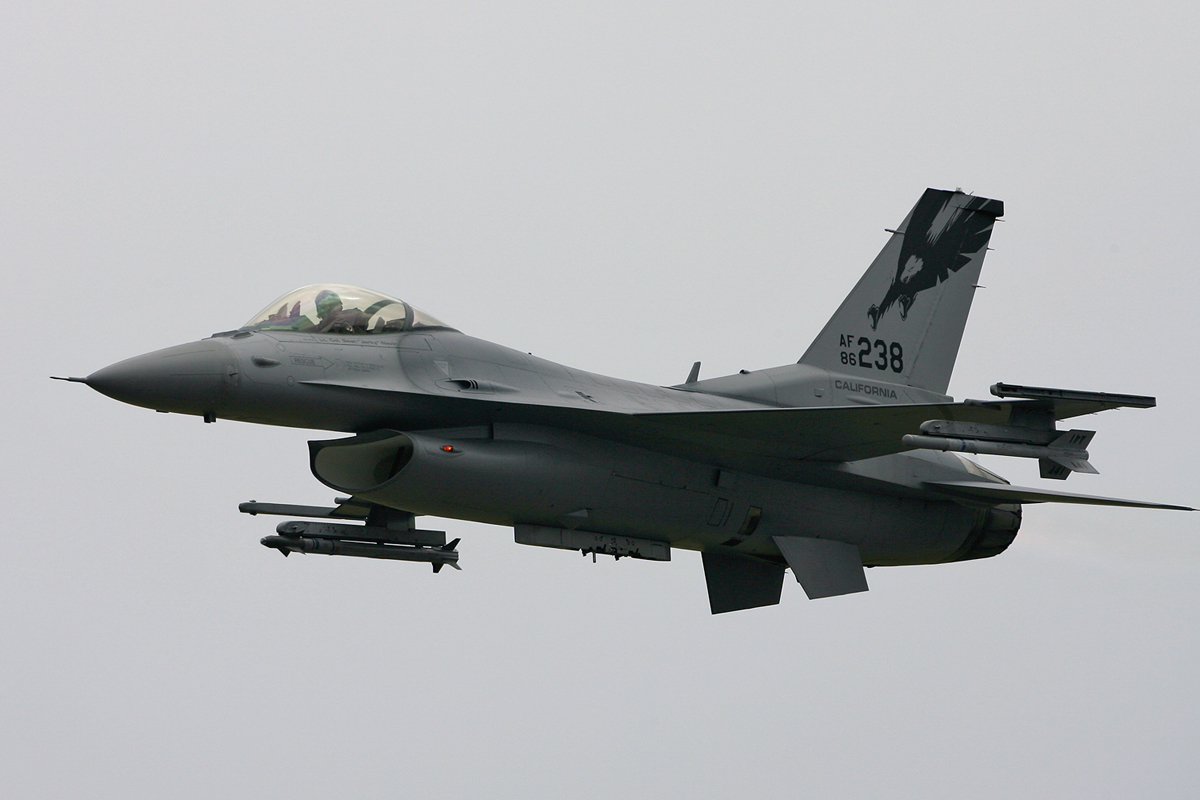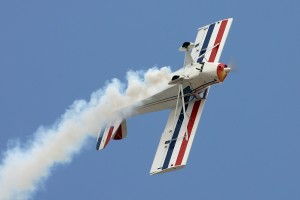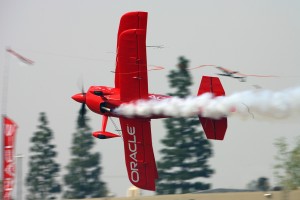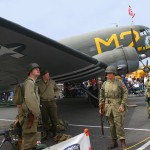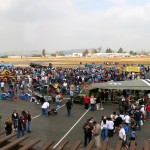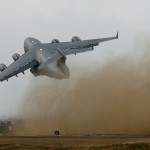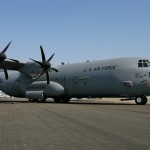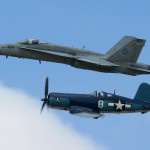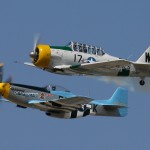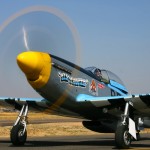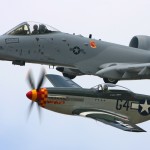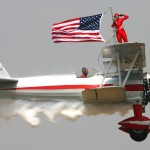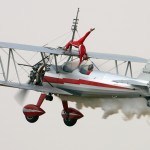By Victor G. Archer
Riverside Municipal Airport (RAL) held its 16th annual Riverside Airshow on March 29. The air show and open house had an impressive mix of vintage airplanes, warbirds and modern military aircraft, as well as hot rods, classic cars and vintage military vehicles. The diverse static display of aircraft included an Air Guard C-130 from the Channel Islands; a Ryan ST-22 trainer; a North American P-51D Mustang, Lady Alice; an Antonov An-2, Big Panda; several North American T-6 Texans and the Commemorative Air Force’s 1943 Douglas C-53D Skytrooper.
The Just in Time Skydivers kicked off the show, making their jump from a classic 1952 D18S Twin Beech. Next, a California Air National Guard F-16 Viper approached low and from the east; using afterburning power, the Viper paid a thunderous visit to the airport and was an electrifying start to the show.
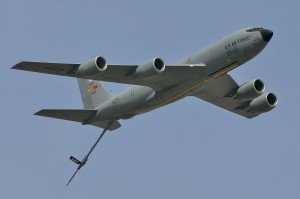
A Boeing KC-135 air refueling tanker, from near by March Air Reserve Base, made a few demonstration passes.
The military made several other appearances during the air show. A Boeing KC-135 air refueling tanker from the 452nd Air Mobility Wing, based at March Air Reserve Base, made several passes while demonstrating the refueling boom and flight charteristics of the Stratotanker. Another high-speed arrival, a Marine Corps F-18C Hornet from VFA-125—the “Rough Riders”—made a couple of afterburning passes before landing.
The air show also treated guests to an old-time aerobatic performance. Based at Cable Airport (CCB) in Upland, Calif., Frank “Dr. D” Donnelly enjoys putting on a show that’s reminiscent of those from the ’50s and ’60s. He flies a 1946 Taylorcraft “T-Cart,” with a Swick conversion to improve aerobatic performance; the plane has shorter wings, larger control surfaces and a 125-hp Lycoming engine. In addition to a dead-stick landing, one of Dr. D’s other favorite maneuvers is the upside-down snake.
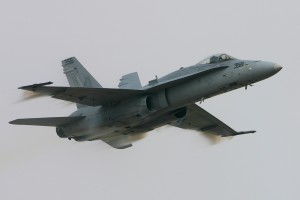
A Marine Corps F-18C Hornet from the VFA-125 Rough Riders, based at Lemoore, Calif., made a few high-speed passes before landing.
Next came graceful aerobatics with power. John Collver, flying his 1944 North American AT-6/SNJ Texan, performed an aerobatic salute to members of the armed forces and its veterans. Collver’s demonstration was full of loops and rolls based on actual maneuvers taught to U.S. fighter pilots during World War II. Collver finished his first performance of the day by racing Bill Braack’s Air Force Reserve-sponsored jet dragster. Even though Collver had a flying start, his airplane was no match for the Westinghouse J-34-powered dragster.
Doug Jardine put on a thrilling aerobatic performance in his Sukhoi SU26 MX. The SU26 is designed for +/- 23g ultimate wing loads and is certified at +12/-10g. The thrust-to-weight ratio is almost 1-to-1 and the roll rate is 400 degrees per second. This rugged design allows Jardine to fly a high-energy routine that consists of multiple tail sliding turns, inverted flat spin, torque rolls, snap rolls, loops and hammerheads, all with smoke on and speeds ranging from zero to 260 mph.
Sean D. Tucker, one of the world’s premier aerobatics performers, put on an amazing display. During his performance, Tucker flew the aircraft backwards, straight down, tail-first at more than 100 mph. Another of Tucker’s signature maneuvers is the triple ribbon cut: he flies through the ribbons at 220 mph in right knife-edge through the first ribbon, then left knife-edge through the second and finally inverted through the last ribbon. The ribbons are only 25 feet off the ground and 750 feet apart. More than half of Tucker’s maneuvers are original, and no other aerobatic pilot has duplicated them.
Next up was a classic wing-walking performance from Silver Wings, featuring pilot Hartley Folstad, wing walker Margi Stivers and their Stearman biplane. Stivers thrilled the spectators with some of her unique poses, including a handstand followed by bending backwards off the top wing and reaching back to the cockpit below.
Legacy, Heritage and commemorative flights
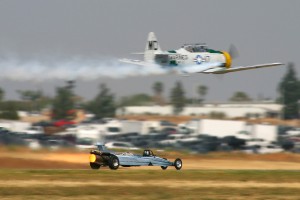
John Collver, flying his AT-6 War Dog, races Bill Braack’s Air Force Reserve-sponsored jet dragster.
An A-10 Thunderbolt II from the Air Combat Command’s West Coast Demonstration Team paired up with Ed Shipley, flying the Planes of Fame Air Museum’s 1945 P-51D Mustang, Wee Willy, for the two-ship USAF Heritage flight. Chuck Hall, flying his P-51D Mustang, flew in tight formation with John Collver, in his 1944 AT-6/SNJ Texan, as a salute to the veterans of WWII. A second Marine Corps F-18C Hornet from VFA-125 joined Chuck Wentworth, flying his1945 Vought F-4U Corsair, to perform the Legacy flight. Afterwards, an F-18 made a couple high-speed passes over the runway.
The Commemorative Air Force treated fans to a mock WWII dogfight, featuring a Japanese-built Mitsubishi A6M3 Zero flown by Jason Somes and a U.S. Navy Grumman F6F Hellcat. Both planes are from the CAF’s base at Camarillo, Calif.
The crowning performance of the show was a Boeing C-17 Globemaster III. The C-17 is the largest aircraft to ever land at Riverside. The pilots taxied backwards the entire length of the runway. After stopping for a moment, the plane took off at a steep angle, approximately 42 degrees. The C-17 made several passes over the field, followed by a remarkable in-field turn.
Making a steep approach to the field, the C-17 made a short landing, using less than half the length of the runway. It stopped right at show center, backed up again under its own power, and then took off within the same short distance (1,500-foot takeoff roll with 88-knot rotation speed) it took to land, again pulling up at a steep angle and banking hard to the left for another pass over the airport. Guests were amazed to see an aircraft that size maneuver through the sky like a fighter.
For more information, visit [http://www.riversideca.gov/airshow].
- A group of WWII re-enactors has CAF Riverside’s 1943 Douglas C-53D Skytrooper, D-Day Doll, as a backdrop.
- Warbirds and people were everywhere.
- A C-17 made a short 1,500-foot takeoff, with a rotation speed of 88 knots.
- A C-17 made a short 1,500-foot takeoff, with a rotation speed of 88 knots.
- The Commemorative Air Force, Camarillo, put on a mock World War II dogfight, featuring a Japanese-built Mitsubishi A6M3 Zero and a U.S. Navy Grumman F6F Hellcat.
- A California Air Guard C-130 from the Channel Islands was just one of the many aircraft on display.
- Chuck Wentworth piloted his 1945 F-4U Corsair alongside a Marine Corps F-18C Hornet, to create the Legacy Flight.
- Chuck Hall flew his P-51D Mustang in tight wingman position with John Collver and his North American AT-6/SNJ Texan.
- Chuck Hall piloted Six Shooter, his 1945 P-51D Mustang.
- Ed Shipley flew the 1945 P-51D Mustang Wee Willy to form up with an Air Combat Command’s West Coast Demonstration Team A-10 Thunderbolt, to form the Heritage flight.
- Wing walker Margi Stivers performed a special tribute to the men and women in the armed forces.
- Silver Wings pilot Hartley Folstad held steady, while wing walker Margi Stivers bent backward off the top wing rack, reaching to the cockpit below.
- Sean D. Tucker performed one of his signature maneuvers, the triple ribbon cut.
- Sean D. Tucker performed multiple rolls in his custom-built Oracle Challenger biplane.











